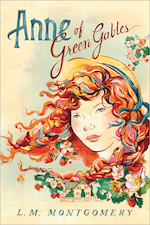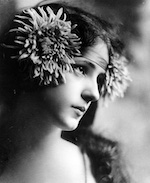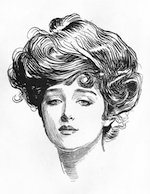 That I have avoided reading this book until now, given its influence on Canadian culture is kind of remarkable. I had read Emily of New Moon for a class on early Canadian literature, but Anne herself had eluded me. Perhaps it was because of the television series. I’ve only seen a few episodes, and those few don’t exactly hold pride of place in my memory, but the show has always seemed emblematic to me of the kind of milquetoast media culture that Canada fostered for most of my youth. Anne is a Good Girl™ and today her story reads like little more than nostalgia for a kind, gentle, primly white and Calvinist Canada that never existed, and is longed for by people whose grandparents likely wouldn’t have been old enough to see it, even if it had. Most of the Canadian media I grew up with, from Air Farce and Beachcombers to Smith & Smith’s Comedy Mill and whatever else you could name, seemed to long for that state of nostalgia, even when making achingly sincere efforts at relevance.[ref]Degrassi, anyone?[/ref] That spirit is today alive and well in the CBC’s Murdoch Mysteries[ref]Particularly in its inability to acknowledge that Canadians know how to properly light a set, or that we can do anything with a camera beyond medium shots.[/ref] and almost any project featuring Paul Gross, though efforts have been made to claw our television culture out of that muck of mediocrity.
That I have avoided reading this book until now, given its influence on Canadian culture is kind of remarkable. I had read Emily of New Moon for a class on early Canadian literature, but Anne herself had eluded me. Perhaps it was because of the television series. I’ve only seen a few episodes, and those few don’t exactly hold pride of place in my memory, but the show has always seemed emblematic to me of the kind of milquetoast media culture that Canada fostered for most of my youth. Anne is a Good Girl™ and today her story reads like little more than nostalgia for a kind, gentle, primly white and Calvinist Canada that never existed, and is longed for by people whose grandparents likely wouldn’t have been old enough to see it, even if it had. Most of the Canadian media I grew up with, from Air Farce and Beachcombers to Smith & Smith’s Comedy Mill and whatever else you could name, seemed to long for that state of nostalgia, even when making achingly sincere efforts at relevance.[ref]Degrassi, anyone?[/ref] That spirit is today alive and well in the CBC’s Murdoch Mysteries[ref]Particularly in its inability to acknowledge that Canadians know how to properly light a set, or that we can do anything with a camera beyond medium shots.[/ref] and almost any project featuring Paul Gross, though efforts have been made to claw our television culture out of that muck of mediocrity.
It may, then, come as a bit of a surprise for readers to learn that I actually quite liked Anne of Green Gables. In fact, I liked it a lot. The book is not the television series, nor is reading it simply a re-tracing of the influence it’s had. Anne is the sort of child people tend to like, precocious and personable—even when her chattiness is annoying it is also endearing—and her eagerness to please and adapt in the face of the hardships of her early life make it almost impossible not to root for her. Her antics are amusing but harmless, and even the people in Avonlea who would most likely be raging assholes in the real world are mostly just tender souls under gruff exteriors. Anne of Green Gables is very, very long on charm.
But there are other interesting things going on. When Anne shuts up long enough to let Montgomery herself get a chance to speak, we find that her narrative voice is rich and lovely, and as easy to spend time with as the very best of the 19th Century novelists who are her true artistic kin. Montgomery’s voice is a bit simpler, a bit more plain, but no less powerful for all that, and I wanted more and more to hear about events from her rather than from the rapid-fire accounts Anne would give to Marilla and Matthew Cuthbert[ref]Matthew is my favourite character, if you were wondering.[/ref].
 The people of Avonlea have complex and varied relationships with the concept of beauty, as Montgomery herself seems to as well. Though frequently called homely or even ugly by a variety of characters, herself included, Anne’s look was apparently inspired by Evelyn Nesbit, a Gibson Girl, a.k.a. one of the models used by Charles Dana Gibson for his sketches of what he considered the pinnacle of female beauty. For most of the book, Anne is either being called ugly in direct or indirect ways, calling herself ugly[ref]Usually pretty directly.[/ref], being upbraided for vanity, or upbraiding herself for vanity. She takes an innocent and infectious pleasure in the beauty of nature, but her whole world, even those who love her most, seem to see beauty of any kind as unnatural, undesirable, and sinful almost beyond measure. And yet. And yet! Marilla and Matthew, both of whom come to love Anne dearly, are secretly proud that she is a lover of beauty and grows up to be beautiful. For all the grumbling and sharp words that Marilla has for Anne about puffed sleeves and other frippery, or for Matthew when he “sticks his oar in” and helps Anne to have something for herself beyond the plainest of dresses,
The people of Avonlea have complex and varied relationships with the concept of beauty, as Montgomery herself seems to as well. Though frequently called homely or even ugly by a variety of characters, herself included, Anne’s look was apparently inspired by Evelyn Nesbit, a Gibson Girl, a.k.a. one of the models used by Charles Dana Gibson for his sketches of what he considered the pinnacle of female beauty. For most of the book, Anne is either being called ugly in direct or indirect ways, calling herself ugly[ref]Usually pretty directly.[/ref], being upbraided for vanity, or upbraiding herself for vanity. She takes an innocent and infectious pleasure in the beauty of nature, but her whole world, even those who love her most, seem to see beauty of any kind as unnatural, undesirable, and sinful almost beyond measure. And yet. And yet! Marilla and Matthew, both of whom come to love Anne dearly, are secretly proud that she is a lover of beauty and grows up to be beautiful. For all the grumbling and sharp words that Marilla has for Anne about puffed sleeves and other frippery, or for Matthew when he “sticks his oar in” and helps Anne to have something for herself beyond the plainest of dresses,  she doesn’t actually see Anne as a vain person who can’t see past the superficial to what matters; she knows that Anne is better than that, and is proud that she can have that relationship with beauty and not be consumed by it. But Anne nevertheless internalizes this self doubt, and she is tortured[ref]Insofar as she is able to be tortured by anything.[/ref] by her inability to not want to be beautiful or to have fine and beautiful things. Much the same is true about the other people in Avonlea. Diana does not want to be vain, but she understands the language of fashion and what it can do. Mrs. Lynde has no time for frippery, except when she does, and she especially does when it’s Matthew who comes calling for help getting a dress for Anne. There is almost no comment about clothing or beauty in this book that does not come laced with anxiety about what it really means or what a character’s relationship to it is, or ought to be.
she doesn’t actually see Anne as a vain person who can’t see past the superficial to what matters; she knows that Anne is better than that, and is proud that she can have that relationship with beauty and not be consumed by it. But Anne nevertheless internalizes this self doubt, and she is tortured[ref]Insofar as she is able to be tortured by anything.[/ref] by her inability to not want to be beautiful or to have fine and beautiful things. Much the same is true about the other people in Avonlea. Diana does not want to be vain, but she understands the language of fashion and what it can do. Mrs. Lynde has no time for frippery, except when she does, and she especially does when it’s Matthew who comes calling for help getting a dress for Anne. There is almost no comment about clothing or beauty in this book that does not come laced with anxiety about what it really means or what a character’s relationship to it is, or ought to be.
Anne of Green Gables makes clear that the past truly is another country, however. I was genuinely shocked to hear the people of Avonlea discussing and trading orphans the way one expects plantation owners might have dealt with the children of slaves in the American South prior to the Civil War. There appears to be no system of adoption that bears much relationship to what we have, or at least try to have, today. Orphans live in asylums or are farmed out to families who look after them, not because they want or can’t have a child to love and raise, but because they need unpaid help around the farm or with the raising of their biological children. Marilla and Matthew Cuthbert are at first seen as foolish for raising Anne because she needs a home[ref]This is in large part why Matthew is my favourite.[/ref], but it shouldn’t be forgotten that Anne’s arrival was a mistake; they, too, initially wanted nothing more than unpaid farm labour. That Anne begins her stay at Green Gables so utterly devoted to doing whatever must be done to be accepted by the Cuthberts is even more profoundly understandable from this perspective, and that Anne managed to retain so much innocence and trust after so long without an accepting home is all the more remarkable, and makes this aspect of her personality less off-putting than it could be[ref]One of the reasons I like Emily of New Moon better as a character is that by comparison she gives zero fucks about what people think of her.[/ref].
I find myself wishing I hadn’t waited so long to read Anne of Green Gables. It is not nearly as interesting a book as Emily of New Moon, but there is so much more going on in it than it would appear at first glance, and Lucy Maud Montgomery’s prose truly is a joy to read, when Anne lets her get a word in edgewise.